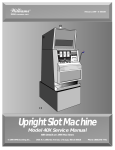Download Sioux Tools 8800ES User's Manual
Transcript
Form Z723 Date 2006January18/C Page 1 of 6 SERVICE INSTRUCTIONS FOR 8800ES 3/8" PROFESSIONAL COMPACT DRILL SERVICE INSTRUCTIONS FOR MODEL NO. 8800ES WARNING Disconnect power before doing any repairs! 4. Place tool on its side and hold firmly. 5. Using a wooden mallet strike the longer end in the clockwise direction. Installation SAFETY Hypot Testing Each 8800ES series tool that is serviced must be Hypot tested before being shipped back to the customer. If you do not have this equipment, you can not service this tool. Hypot testing is a safety test required by Underwriters Laboratories. It basically ensures that there are no live metal parts exposed on the product. This condition could occur if, for instance: 1. Screw the chuck on by hand as far as it will go. 2. Insert screw (left-hand thread), and tighten screw securely. 3. Tighten the chuck around the shorter end of a 1/4 or larger hex key, then strike the longer end in the clockwise direction with a wooden mallet while holding down the tool securely. 4. Tighten the screw once again by turning in a counterclockwise direction. BRUSH REMOVAL / INSTALLATION Removal 1. A housing screw went through a wire. 2. A wire was stripped back too far and the bare wire contacted a bearing or the driveshaft. 1. Remove brush cap using a flat-head screwdriver. 2. Remove brush assembly from the brush holder. 3. A wire was damaged and came into contact with a bearing or the driveshaft. Installation 1. Installation is the reverse of the removal instruction above. This is a very serious safety issue so please take care to test the tool as specified below. The tool is to be Hypot tested at 3000 VAC for 1 second between: GEARBOX REMOVAL / INSTALLATION A. Both power cord prongs and the chuck with the power switch in the ON position. Currently, the gearbox components are not individually available, and in the event of a failure, the entire gearbox must be replaced. B. Between the power cord prongs and all of the housing screws with the power switch in the ON position. The procedure for removing / installing the gearbox is as follows: Removal The maximum allowable current is 0.5mA. 1. Remove the chuck as described above. 2. Remove the brush caps and take out the brushes. The brushes should always be removed before disassembling the housing. REPAIR The following are specific instructions for repairing the 8800ES drill. For a list of available service parts and an exploded-view product drawing, please refer to the last page of this manual. 3. Remove the (8) housing screws and remove the right housing half. While removing the right housing half, disconnect the yellow brush lead from the brush holder. This can usually be disconnected with your fingers. If not, a needle-nose pliers will suffice. These repair instructions start with the very basic repairs such as replacing a chuck and progress to the more complicated such as replacing a housing. They are done this way so all of the information does not have to be repeated. For this reason you may want to read the entire instruction before proceeding with one of the more complicated repairs. 4. Remove the chuck shroud. 5. Lift up the gearbox so that the motor assembly tips upward. Once the gearbox is above the left housing half, pull it away from the motor so the input shaft pulls out of the motor coupling. Installation CHUCK REMOVAL / INSTALLATION Removal 1. Open chuck jaws to maximum capacity. 2. Remove retaining screw on tool by turning it in a clockwise direction (screw has a left-hand thread). 3. Insert the shorter end of a 1/4 or greater hex key into chuck and tighten. 1. Remove the armature while leaving the field in place. In order to remove the armature, you will have to tip up the field so that the fan clears the housing. 2. Ensure that there is grease in the motor coupling and that the o-ring is in place in the end of the coupling. If grease must be added, a light film of any moly based grease will be adequate. 2 3. Insert the gearbox into the coupling assembly. 4. Tip up the field and slide the gearbox/armature assembly into location. 5. Reseat the field and make sure the armature spins freely. 6. Remainder of assembly is the reverse of the removal procedure above. MOTOR COUPLING REMOVAL / INSTALLATION Removal SWITCH REMOVAL / INSTALLATION Removal 1. Remove the chuck as described above. 2. Remove the top housing half as described above. 3. Remove the reversing shuttle from the top of the switch. 4. Disconnect the 4 leads from the reversing module (top portion) of the switch. These should slide straight up and disengage. 5. Loosen the two Phillips head machine screws on the side of the switch and remove the power cord wires. 2. Remove the top housing half and gearbox as described above. 6. The red brush wire installed in the bottom of the switch can be removed by pushing a small diameter pin in the wire opening. This will open the wire trap and the wire can be pulled out. 3. Remove the armature from the tool as described above. NOTE: Again, take note of the wire routing before disassembly so they can be properly routed upon reassembly. 4. The coupling is press fit onto the knurled end of the motor shaft. Remove the coupling using an arbor press or other suitable press. With the armature pointed upward, the coupling should be held from the bottom side and the armature pressed down. Installation 1. Remove the chuck as described above. Installation 1. Install a light film of moly based grease to the inside of the coupling both in the large and small diameter bores. 2. Remainder of the installation is the reverse of the removal instruction above. NOTE: It is very important that the coupling be lined up properly during installation. Failure to install the coupling straight will result in tool vibration. 1. Installation is the reverse of the removal instruction above. CAUTION: It is extremely important that the wires that terminate in the reversing module of the switch be properly installed. When properly installed, the top of the terminals will be about flush with the top of the switch. Proper installation ensures adequate spacing between the switch terminals, which are live, and the gearbox, which is metal and has a conductive path to the chuck. Ensure that the spacing between the switch terminals and gearbox is adequate before reassembling the top housing half. Terminals may not extend beyond the top surface of the switch. MOTOR REMOVAL / INSTALLATION Removal 100% inspect to see that the terminal is pushed down all the way and that there are no excessive lumps of solder. 1. Remove the chuck as described above. 2. Remove the top housing half and gearbox as described above. 3. Remove the armature from the tool. 4. Disconnect the black and white lead wires from the field and remove it. The thicker black jumper wire should not be disconnected Improper Switch Wire Assembly 100% inspect for proper connection. NOTE: During disassembly, take note of wire routing so the wires can be routed the same way upon reassembly. Also take note of the way the two dowel pins on the fan end of the field engage the lower housing. Installation 1. Installation is the reverse of the removal instruction above. When properly installed, the terminals on the switch wires are fllush with the top of the switch as shown in the pictures above. Proper Switch Wire Assembly 3 HOUSING REPLACEMENT Removal One of the wires from the power cord must be placed in on top of each bundle of switch wires and pressed firmly into place. This will hold the wires down and away from the motor coupling. 1. Remove the chuck as described above. 2. Remove the top housing half and gearbox as described above. 3. Remove the armature from the tool. 4. Remove the field as described above 5. Remove the switch as described above. 6. Remove the power cord from the tool. It should just pull out of the wire channel. 7. Disconnect the red brush lead from the brush holder in the left housing half and remove the switch wiring harness. Like the power cord, this should pull right out. Power Cord Routing 8. Press the brush holders out of each housing half. Installation 1. Install a service warning label on the new housing. The service warning label is only partially laminated. Half of the label has a backing on the lamination that can be peeled off allowing the technician to write on the label and finish laminating it him/herself. Record the tool serial number with a pen on the label, peel the backing off of the lamination, and laminate the service warning label. 2. Install new decorative and brand labels if desired. As an aid to reassembly, take note of wire routing and position in wire guides and traps while dismantling tool. White wire #5 is to be routed around the lower brush boss between the boss and the field. Yellow wire #7 must pass under the power cord wire and exit between the cord strain relief and the screw boss. This allows enough slack to attach the wire to the upper brush holder while lowering the housing. 3. The remainder of assembly is the reverse of the removal instruction above. White WIRE ROUTING / REPLACEMENT As noted in the above sections, it is very important to note the routing of the wires before disassembly. They must be routed exactly the same way upon assembly. Some additional detail on proper wiring follows. It is very easy to pinch a wire when reassembling a tool if care is not given to wire routing. Take note of which ribs contact the switch and field, and where wires must be routed to clear them. The bundle of 4 switch wires must be placed with 2 of the wires in each of the 2 wire slots provided as the wires pass under the motor coupling. Switch Wire Routing 4 Yellow TORQUE SPECIFICATIONS WIRING SPECIFICATIONS Wire No. Wire Color Origin or Gauge Length 1 White Cord 8.6" 2 3 4 5 6 7 Black Black Grey White Red Yellow Cord R. Field Switch L. Field L. Brush R. Brush 8.6" 10.2" 2.5" 11" 8.7" 11" The following torque specifications are recommended for the 8800ES drill: Chuck: 40-60 in-lb Chuck Retaining Screw: 35-45 in-lb Switch Terminal Screws: 3-6 in-lb Housing Screws 10-14 in-lb When tightening the housing screws, if you do not have a tool with which you can limit the tightening torque, they should be tightened by hand to prevent stripping. If a screw hole is stripped, the tool housing must be replaced. NOTE: All lead lengths are overall. PERFORMANCE SPECIFICATIONS An acceptable tool is expected to perform as follows: FIELD 8800ES 7 6 REVERSING MODULE 8 5 RIGHT BRUSH SWITCH 1 6 1 2 1 BLACK 7 2 RED YELLOW < 1.7A NOTE: Tool may run slower than above after installation of new brushes. It takes about 10 minutes of run time to fully seat new brushes. GRAY 4 WHITE WHITE BLACK No-Load Amp Draw 1350-1650 RPM 5 3 FRONT No-Load Speed LEFT RIGHT 2 CORD LEFT BRUSH 5 PARTS LIST FOR MODEL NO. 8800ES 5 3 4 2 1 21 12 14 11 12 6 7 13 8 11 22 17 16 12 9 20 18 15 12 10 19 15 Key Part No. No. 1 SP57250R 2 SP68393 3 SP68398 4 SP25680 5 SP68624 6 SP68406 7 SP68395 8 SP68411 9 SP30632 10 SP68410 11 SP68788 12 SPME3L26A 13 SP6868719 14 SP68718 15 SP68245 16 SP68244 17 SP68243 18 SP68099 Key No. 19 20 21 22 Description Screw (M5 x .8 x 20 LH Torx Mach) Chuck Chuck Shroud Washer Gear Box O-Ring Coupling Armature Roll Pin (2)* Field Housing Set Housing Screw (8)* Switch Reversing Shuttle Brush Set Brush Holder (2)* Brush Cap (2)* Cord Part No. SP68723 SP68722 SP68721 SP68790 Not Shown SP30002 Z718 SP68238 SP68587 8800ESLC 6 16 17 Description Decorative Label Brand Label, Left Brand Label, Right Service Warning Label KeyNot Shown Owner's Manual Switch Jumper Wire Assembly Wiring Harness Assembly 8800ES 3/8" Drill Less Chuck and Key









